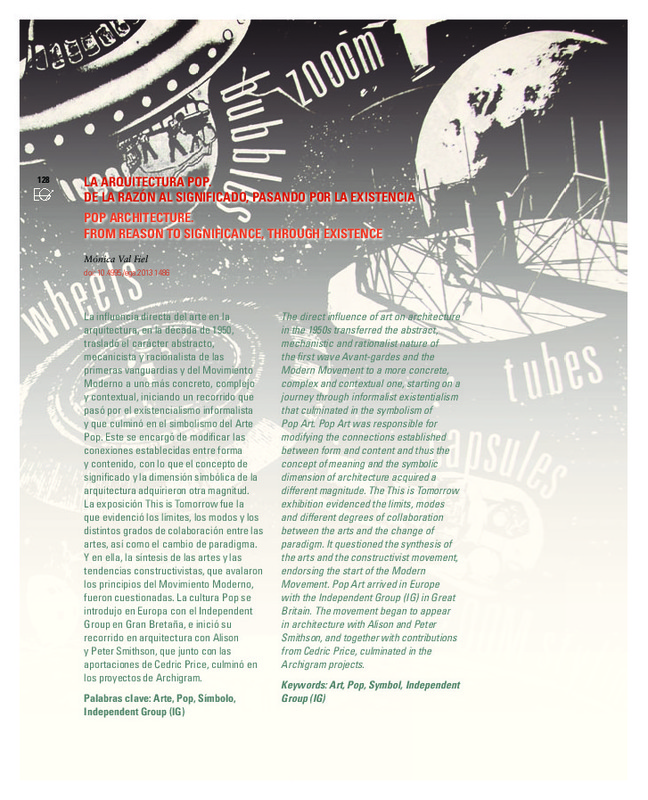JavaScript is disabled for your browser. Some features of this site may not work without it.
Buscar en RiuNet
Listar
Mi cuenta
Estadísticas
Ayuda RiuNet
Admin. UPV
La Arquitectura Pop. De la razón al significado, pasando por la existencia
Mostrar el registro sencillo del ítem
Ficheros en el ítem
| dc.contributor.author | Val Fiel, Mónica
|
es_ES |
| dc.date.accessioned | 2013-09-25T09:44:38Z | |
| dc.date.issued | 2013 | |
| dc.identifier.issn | 1133-6137 | |
| dc.identifier.uri | http://hdl.handle.net/10251/32342 | |
| dc.description.abstract | [EN] The direct influence of art on architecture in the 1950s transferred the abstract, mechanistic and rationalist nature of the first wave Avant-gardes and the Modern Movement to a more concrete, complex and contextual one, starting on a journey through informalist existentialism that culminated in the symbolism of Pop Art. Pop Art was responsible for modifying the connections established between form and content and thus the concept of meaning and the symbolic dimension of architecture acquired a different magnitude. The This is Tomorrow exhibition evidenced the limits, modes and different degrees of collaboration between the arts and the change of paradigm. It questioned the synthesis of the arts and the constructivist movement, endorsing the start of the Modern Movement. Pop Art arrived in Europe with the Independent Group (IG) in Great Britain. The movement began to appear in architecture with Alison and Peter Smithson, and together with contributions from Cedric Price, culminated in the Archigram projects. | es_ES |
| dc.description.abstract | [ES] La influencia directa del arte en la arquitectura, en la década de 1950, trasladó el carácter abstracto, mecanicista y racionalista de las primeras vanguardias y del Movimiento Moderno a uno más concreto, complejo y contextual, iniciando un recorrido que pasó por el existencialismo informalista y que culminó en el simbolismo del Arte Pop. Este se encargó de modificar las conexiones establecidas entre forma y contenido, con lo que el concepto de significado y la dimensión simbólica de la arquitectura adquirieron otra magnitud. La exposición This is Tomorrow fue la que evidenció los límites, los modos y los distintos grados de colaboración entre las artes, así como el cambio de paradigma. Y en ella, la síntesis de las artes y las tendencias constructivistas, que avalaron los principios del Movimiento Moderno, fueron cuestionadas. La cultura Pop se introdujo en Europa con el Independent Group en Gran Bretaña, e inició su recorrido en arquitectura con Alison y Peter Smithson, que junto con las aportaciones de Cedric Price, culminó en los proyectos de Archigram. | es_ES |
| dc.language | Español | es_ES |
| dc.language | Inglés | |
| dc.publisher | Editorial Universitat Politècnica de València | |
| dc.relation.ispartof | EGA. Revista de Expresión Gráfica Arquitectónica | |
| dc.rights | Reserva de todos los derechos | es_ES |
| dc.subject | Art | es_ES |
| dc.subject | Symbol | es_ES |
| dc.subject | Arte | es_ES |
| dc.subject | Pop | es_ES |
| dc.subject | Símbolo | es_ES |
| dc.subject | Independent Group (IG) | es_ES |
| dc.title | La Arquitectura Pop. De la razón al significado, pasando por la existencia | es_ES |
| dc.title.alternative | Pop architecture. From reason to significance, through existence. | es_ES |
| dc.type | Artículo | es_ES |
| dc.date.updated | 2013-09-24T09:46:21Z | |
| dc.identifier.doi | 10.4995/ega.2013.1486 | |
| dc.rights.accessRights | Abierto | es_ES |
| dc.contributor.affiliation | Universitat Politècnica de València. Departamento de Expresión Gráfica Arquitectónica - Departament d'Expressió Gràfica Arquitectònica | es_ES |
| dc.contributor.affiliation | Universitat Politècnica de València. Escuela Técnica Superior de Ingeniería del Diseño - Escola Tècnica Superior d'Enginyeria del Disseny | es_ES |
| dc.description.bibliographicCitation | Val Fiel, M. (2013). La Arquitectura Pop. De la razón al significado, pasando por la existencia. EGA. Revista de Expresión Gráfica Arquitectónica. 18(21):128-139. https://doi.org/10.4995/ega.2013.1486 | es_ES |
| dc.description.accrualMethod | SWORD | es_ES |
| dc.relation.publisherversion | https://doi.org/10.4995/ega.2013.1486 | es_ES |
| dc.description.upvformatpinicio | 128 | es_ES |
| dc.description.upvformatpfin | 139 | es_ES |
| dc.description.volume | 18 | |
| dc.description.issue | 21 | |
| dc.identifier.eissn | 2254-6103 | |
| dc.description.references | – DE SOLÁ MORALES, Ignasi. Diferencias, Topografía De La Arquitectura Contemporánena. Barcelona: Gustavo Gili, 1995. | es_ES |
| dc.description.references | – DE SOLÀ-MORALES, Ignasi; and SASSEN, Saskia. Territorios. Barcelona: Gustavo Gili, 2002. | es_ES |
| dc.description.references | – FOSTER, Hal. The Art-Architecture Complex. London; New York: Verso, 2011. | es_ES |
| dc.description.references | – GUASCH, Anna M., El Arte Del Siglo xx En Sus Exposiciones. 1945-2007. Barcelona: Ediciones del Serbal, 2009. | es_ES |
| dc.description.references | – IVAM Centre Julio González. El Independent Group: La Postguerra Británica y La Estética De La Abundancia [Exposición, IVAM, 12 Junio Al 26 Agosto 1990]. València: IVAM Centre Julio González, 1990. | es_ES |
| dc.description.references | – MARCHÁN FIZ, Simón. Del Arte Objetual Al Arte De Concepto: Las Artes Plásticas Desde 1960. Madrid: Alberto Corazón, 1972. | es_ES |
| dc.description.references | – MASSEY, Anne. The Independent Group: Modernism and Mass Culture in Britain, 1945-59. Manchester: Manchester University Press, 1995. | es_ES |
| dc.description.references | – MATHEWS, Stanley. From Agit-Prop to Free Space: The Architecture of Cedric Price. London: Black Dog Pub. Ltd, 2007. | es_ES |
| dc.description.references | – MONTANER, Josep M. Después Del Movimiento Moderno: Arquitectura De La Segunda Mitad Del Siglo xx. Barcelona: Gustavo Gili, 1993. | es_ES |
| dc.description.references | – MONTANER, Josep M. La Modernidad Superada: Arquitectura, Arte y Pensamiento Del Siglo xx. Barcelona: Gustavo Gili, 1997. | es_ES |
| dc.description.references | – STEINER, Hadas A. Beyond Archigram: The Structure of Circulation. New York: Routledge, 2009. | es_ES |








